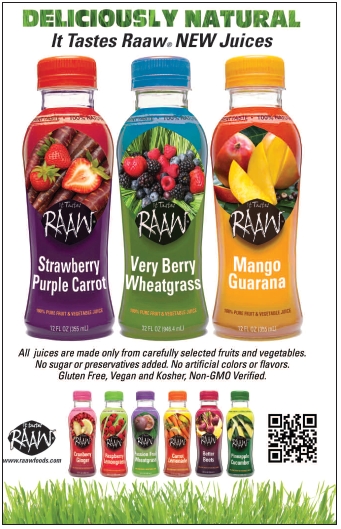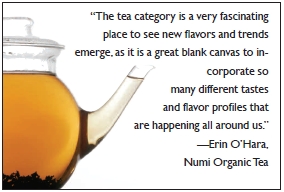Whether we’re gulping, sipping or slurping, beverages are a major part of our dietary intake. Drinks are so important that their sweeteners, calorie content, energy boosting quality and the like have been under the microscope. Here, we review some of the most recent beverage-related news stories and how they have affected the natural/organic products industry.
Durbin Asks FDA for Better Regulation of Energy Drinks
Since April, Senators Richard Durbin (D-IL) and Richard Blumenthal (D-CT) have gone back and forth with the U.S. Food and Drug Administration (FDA) over whether the agency could and should take more aggressive steps to regulate energy drinks. In the senators’ view, some energy drinks are unsafe because they mix caffeine and natural energy boosters (like guarana and ginseng) and thus should have a caffeine limit of 0.02%, as is the case for soft drinks (equating to about 71 mg in a 12-oz soda). Some products, they feel, are actually supplements, but are sold in sizes that look more like drinks.
FDA wasn’t convinced, saying in an August letter that energy drinks have similar  caffeine contents to coffee and that as much as 400 mg/day is generally considered safe in healthy people. It also noted that it plans to release a guidance about distinguishing liquid supplements from beverages. But, Durbin and Blumenthal didn’t stop there, and in September, wrote another letter telling the agency its response wasn’t good enough. The senators said companies are using guarana and taurine to add flavor, but the ingredients also have a stimulating effect. The letter said the 400 mg/day guideline isn’t appropriate, for younger individuals, many of whom take energy drinks and thus action is needed.
caffeine contents to coffee and that as much as 400 mg/day is generally considered safe in healthy people. It also noted that it plans to release a guidance about distinguishing liquid supplements from beverages. But, Durbin and Blumenthal didn’t stop there, and in September, wrote another letter telling the agency its response wasn’t good enough. The senators said companies are using guarana and taurine to add flavor, but the ingredients also have a stimulating effect. The letter said the 400 mg/day guideline isn’t appropriate, for younger individuals, many of whom take energy drinks and thus action is needed.
Energy Drink Market Analysis. According to sales figures from Canadean’s Quarterly Beverage Tracker, USA, Second Quarter August 2012, the public is clearly not letting the negative press raised by Durbin and Blumenthal decrease their energy drink purchases. In fact, consumption spiked over 15% in Q2 2012 (1). Individuals with on-the-go, “wired 24/7” lifestyles are pushing sales in this category (and in iced and ready-to-drink products), according to Canadean (1, available at www.wholefoodsmagazine.com/marketresearch).
If anything, Durbin’s press may have raised awareness about the ingredients in energy drinks, and this is good news for the natural and organic channel. States Toby Scheckter, founder and CEO of Scheckter’s OrganicEnergy, “Most come to the realization that [mainstream energy drinks] aren’t as healthy as we are conditioned to believe, apart from some of the healthier energy drink alternatives.”
For this reason, his company combines organic ingredients like green tea, green coffee bean extract and ginseng, which have long been used for energizing. “This is the healthiest way energy drinks can create a natural and refreshing drink,” Scheckter states. “Anything you cannot recognize as being a ‘real’ food and can be considered processed and artificial should be left out of the drink entirely.”
Mushrooms, the B-vitamins and other natural ingredients that support energy also appeal to shoppers looking to avoid the spikes and crashes that artificially caffeinated drinks cause. Sandra Carter, M.A., M.Ph., Ph.D., CEO of Matrix HealthWerks (maker of NRG Matrix energy drink), San Marcos, CA, explains the mushroom side of the story: “Cordyceps and reishi mushroom promote natural long-duration energy with increased oxygenation of the blood and increased ATP production—both vital for increasing duration and intensity of exercise, training and competition.” Meanwhile, B12 is involved in energy production, and is good for avoiding fatigue.
Gatorade, PowerAde Makers Accused of Making False Claims
In July, a British Medical Journal (BMJ) study questioned claims made by sports drinks makers and stated that the research behind such sports drinks is of very low quality. Their additives (like sugar, artificial colors and flavors) increase the calorie content and have caused the National Hydration Council to recommend water over sports drinks.
Sports Drinks Market Analysis. While the BMJ study has methodological flaws, it raised the point that the ideal consumers for sports drinks are athletes and those that exercise rigorously. In addition, the research may have had a similar effect to what we saw in the energy drink category: shoppers want to know what’s in their drink and why. For many, this means natural and organic options are highly appealing.
 According to Carter, “Sports drinks should support hydration—key for sports nutrition.” Her company formulated its energy drink with this purpose and to “provide natural nutrition with high levels of antioxidants, vitamin D, vitamin C, vitamin B1, B3, B6 and B12, minerals, enzymes and other nutrients that naturally promote health and fitness.”
According to Carter, “Sports drinks should support hydration—key for sports nutrition.” Her company formulated its energy drink with this purpose and to “provide natural nutrition with high levels of antioxidants, vitamin D, vitamin C, vitamin B1, B3, B6 and B12, minerals, enzymes and other nutrients that naturally promote health and fitness.”
The ingredients behind this brand are whole foods, dehydrated organic medicinal mushrooms and organic botanicals plus vitamin C and natural flavorings. Mushrooms, while not common in your run-of-the-mill energy drink, were selected for good reasons. Says Carter, “The high levels of vitamin D, vitamin B1, B3, B6 and B12 are all naturally contained in the medicinal mushrooms and in the organic botanicals. The medicinal mushrooms also provide immune-enhancing beta glucans, non-soluble fiber and an array of enzymes and minerals.” The medicinal mushroom blend also offers l-ergothioneine, which helps reduce the byproducts of exercise and improve muscle recovery.
Overall, sports drinks should be considered a strong category for retailers, with sales rising 4% in Q2, according to Canadean (1). The firm expects that sales in 2012 will beat those from 2011, with a combined 7% growth.
Other data suggest savvy retailers may get a bump from private label sports drinks. “Private label will begin to make an impact on this category, which hitherto has been dominated by two major players,” states Canadean (1). The group notes that GNC recently introduced its first mainstream line of private label drinks, which included 14 products “across the sports nutrition, nutritional waters and protein nutrition categories” (1).
Fungicide Found in Mainstream Orange Juice
Juice drinkers were soured at the thought of carbendazim in their OJ. Coca-Cola found traces of the dangerous fungicide in its Minute Maid orange juice, while PepsiCo also detected low levels of it in Tropicana.
Juice Market Analysis. According to Matt McLean, CEO of Uncle Matt’s, Clermont, FL, this news had a positive effect on organic juice manufacturers, like his company. “We abide by organic regulations. We don’t use any synthetic fungicides like carbendazim. You won’t find it in an organic product like Uncle Matt’s,” says McLean.
He reports that his company saw a spike in awareness about  organic juices, and in “the understanding that you can have an option without synthetic fertilizers.” McLean noted an uptick in interest from parents who wanted to be sure their children’s juices are free of chemicals and synthetic fertilizers.
organic juices, and in “the understanding that you can have an option without synthetic fertilizers.” McLean noted an uptick in interest from parents who wanted to be sure their children’s juices are free of chemicals and synthetic fertilizers.
An organic farmer has USDA approved materials that can be used in lieu of fungicides. “One thing we use is compost, which creates good bacteria that fights the bad and out-competes the fungus. We have a variety of methods that we use,” says McLean.
McLean also confirms that there was a bump in sales for his company’s organic juices.
Other natural companies benefitted, too. GoodBelly, has grown its line of natural probiotic juices. Alan Murray, CEO of GoodBelly, Boulder, CO, says one hot new launch was a GoodBelly 10 Ounce Probiotic Coconut Water. Coconut water has been popular as an electrolyte and hydration enhancer, and the probiotics add digestive health benefits.
The firm also confirms that customers are constantly looking for interesting, exciting flavors. “The most interesting flavor combinations available to consumers contain fresh and unique ingredients that also offer a variety of health benefits,” says Murray. GoodBelly has met this need with flavors like pomegranate blackberry and blueberry acai “because they are exotically delicious ingredients that also offer a number of health benefits,” Murray says. Taste and benefit are some of the most important factors in the functional beverage industry, he states. “Consumers today want the biggest bang for their buck, and that absolutely applies to ingredients and flavors.”
Raw Milk Raids Continue, Alternatives Sought
In 2011, fans were crying over spilt milk as Rawesome Foods of Venice, CA was raided a second time by federal agents and owner James Stewart was arrested. While the Centers for Disease Control and the Mayo Clinic say unpasteurized milk can harbor bacteria that can lead to illness, proponents feel there are some benefits.
 Says Reta Sanden, consumer services at Meyenberg Goat Milk Products, Turlock, CA, “While there is very little nutritional change to pasteurized milk from raw milks, some people feel that raw milks are better suited for making things like cheeses and yogurts than with pasteurized milk. People also believe some of the natural cultures in raw milk are lost once milk has been pasteurized.”
Says Reta Sanden, consumer services at Meyenberg Goat Milk Products, Turlock, CA, “While there is very little nutritional change to pasteurized milk from raw milks, some people feel that raw milks are better suited for making things like cheeses and yogurts than with pasteurized milk. People also believe some of the natural cultures in raw milk are lost once milk has been pasteurized.”
The legality of selling raw milk varies widely across the country, with some states banning it completely. Regardless of which side you take on the raw milk front, retailers know that shoppers are passionate about their milk. The industry has seen increased interest in everything from DHA-infused organic milk to coconut milk to almond milk to blends and beyond.
Stores should also be prepared to receive more inquiries about goat’s milk. While 65% of the world drinks goat’s milk (according to Joseph Stout, M.S., president of Mt. Capra, Chehalis, WA [2]), it is still somewhat novel to many U.S. shoppers. “Goat milk is the most consumed milk worldwide, even over cow’s milk. But because cows can create more milk than goats, it is easier to supply large nations like the United States with the milk from cows,” says Sanden.
Goat’s milk is growing in popularity in the States for several reasons. First off, the way it is digested is very different from cow’s milk. In fact, the protein structures in goat’s milk are smaller than those found in cow’s. “Goat milk’s molecular structure is closer to human milk in its makeup. This makes goat milk more easily digested than cow milk for some people,” Sanden states. “Goat milk is digested in about 30 minutes; cow’s milk and some other alternative milks can take longer—up to three hours in some cases. This longer digestive time allows the milk to ferment in the lower digestive system leading to allergic reactions.”
Jennifer Lynn Bice, CEO of Redwood Hill Farm & Creamery and Green Valley Organics Lactose Free, Sebastopol, CA, adds, “Those that are lactose intolerant can usually use goat milk as the lactose in goat milk has a different make-up and most are not intolerant to it.” She adds, however, that there are new alternatives in lactose-free cow dairy. “There are now lactose-free yogurts, kefir and sour cream in addition to lactose-free milk. This is a great option as the real dairy option contains the calcium that is so important.”
Many people’s “lactose intolerance” is actually an allergy to the alpha s1 casein in cow milk. According to Stout, “The levels of alpha s1 casein in goat’s milk are about 89% less than cow’s milk, providing a far less allergenic food. In fact, a recent study of infants allergic to cow’s milk found that nearly 93% could drink goat’s milk with virtually no side effects” (2).
And while goat’s milk is not lactose free, it also contains much less lactose than milk and is easier to digest for many people. “Since goat milk is so easily digested, the lactose is also metabolized quickly and does not stay in the intestines causing osmotic imbalances and gastric distress,” says Stout (2).

|
| photo of goat photo courtesy of Mt. Capra Wholefood Nutritionals |
Bice notes that goat’s milk is processed differently than the cow variety, too. She states, “Because of the smaller butterfat globules in the goat’s milk, it makes it easier to digest and is also the reason that the butterfat in goat milk does not rise to the top and why goat milk does not need homogenization.” Homogenization doesn’t appeal to all shoppers (hence, in part, the upsurge in shoppers looking for raw milk). Stout says that during this process, the milk fat’s cellular wall is destroyed and a free radical called xanthine oxidase is released from inside (2).
In addition, Stout says the globules in goat’s milk also contains higher levels of medium-chain fatty acids. “Not only are these medium-chain fatty acids better for you, they are easier for your body to digest because they have a larger surface-to-volume ratio. Likewise, when the protein in goat’s milk begins the digestion process, they form a soft bolus in the stomach unlike cow’s milk, which takes on the form of a large hard-to-digest ball,” he explains (2).
Other differences include the fact that goat’s milk tends to contain more protein and calcium than cow’s milk, and also is a source of potassium and vitamin A. As for the taste, Sanden says “Goat’s milk should be very creamy, sweet with a slight nutty flavor and a bit of tang to it. This unique flavor gives goat milk products a great taste advantage over cow milk-based butters and cheese.”
Another trend in the dairy category are probiotic beverages like lactose-free kefir. Bice says these are some of the fastest growing items in the dairy category. “They contain the probiotics that yogurt has become famous for and in many cases, in much higher numbers,” she says.
Milk May Deplete Green Tea’s Antioxidant Benefits
Earlier this year, the European Journal of Nutrition printed this surprising finding: adding milk to green tea reduces the bioavailability of its catechins (3). Blood tests of 24 women who drank tea with skim milk, with caseinate, with soy protein or plain confirmed this finding. In 2007, researchers also found that milk counteracted the heart health benefits of tea, as milk proteins bound to and neutralized the antioxidants (4).
Tea Market Analysis. While this research likely didn’t sway shoppers from forgoing tea time, it raises the visibility that many people drink tea not only for comfort and warmth, but also for function. According to SPINs data (52 weeks ending June 9, 2012) supplied by Traditional Medicinals, Sebastopol, CA, medicinal teas are the largest driver in the tea category. According to the company, medicinal teas have had three years of double-digit growth, and medicinal teas could have a growth opportunity of $200 million by 2017.
Traditional Medicinals says this growth is aligned with the current trend of shoppers wanting natural ways to maintain wellness.
Canadean also has noted that sales of tea for home consumption continue to grow, and there’s also been an uptick in the variety of tea products. “Green tea and spiced tea in particular are growing in popularity,” says the research firm (2).
Likewise, Blake Waltrip, vice president and chief marketing officer of Celestial Seasonings, Boulder, CO, feels, “Wellness teas represent a large growth opportunity, as consumers show continued preference for teas that provide condition-specific and everyday wellness solutions as alternatives to over-the-counter products.”
Such teas in the Celestial Seasonings line (like Sleepytime Echinacea Complete Care and Sleepytime Sinus Soother) “are growing nearly twice as fast (+15.7%) in the Natural channel as the overall Wellness segment (+8.4%)” (according to SPINS, 52 weeks ending 2/18/12), says Waltrip.
Other companies note that tea is attracting new followers, not just customers. States Anne-Marie Phillips, head of sales and marketing at Choice Organic Teas, Seattle, WA, “These are aspiring aficionados who educate themselves as diligently as wine connoisseurs, learning everything about their favorites, from the terroir and tea garden in which it is grown, to the proper teaware from which to enjoy it, to the formal cupping or tasting protocol with which to compare and contrast teas.” She adds that this group includes everyone from college students to veteran tea drinkers.
These folks are most interested in organic, fair trade and high-quality teas. According to Linda Appel Lipsius, co-founder and CEO of Teatulia, Denver, CO, they are likely interested in the whole-leaf variety in addition to bags. “Tea is still so new to American consumers and they are really enjoying learning more about this ancient beverage and experimenting with different ways to prepare it—loose, bags, iced, hot, as a cocktail base,” she states.
Since experimentation is welcome among tea drinkers, it’s noteworthy that Waltrip feels, “’treasure hunt’ in the tea aisle is part of the allure for consumers.” He flags Rooibos—known for its restorative qualities in South Africa— as “enjoying increased popularity for stretches that often last several years.”
Other beneficial teas are also surging in popularity. “Another example is oolong, which grew to become our number one seller after being mentioned by Dr. Oz as a metabolism booster,” Phillips notes, “Green tea also remains as popular as ever, especially while its many health benefits continue to be featured in the media.”
One type of tea that combines interest in exotic with a desire for function is pu-erh. “Pu-erh tea’s unique fermentation process not only provides its unique smooth and earthy taste, but also the health benefits that have been touted for generations,” explains Erin O’Hara, product marketing manager for Numi Organic Tea, Oakland, CA. She adds that it’s known as “the skinny girl’s tea” in Taiwan because it helps break down grease and aids with digestion. “Pairing pu-erh with other herbs and spices complements the health benefits—like ginger, which is known to settle the stomach,” says O’Hara.
Kombucha is another tea product that devotees turn to for its health properties. According to GT Dave, CEO and founder of GT’s Kombucha, Beverly Hills, CA, “Kombucha is a hand-crafted organic tea that is delicately cultured with live probiotics and active enzymes. It is usually cultured for as little as 10 days or for as many as 30 days.”
Adds Waltrip, “When added to sweetened black tea, the SCOBY [self-propagating symbiotic colony of bacteria and yeast] quickly consumes most of the sugar—producing a fermented ‘kombucha tea’ with a range of nourishing organic acids and a pleasant effervescence.”
Dave explains that these nutrients help the body to detoxify, “restoring it to a more balanced state and strengthening its natural defenses.”
As for other emerging trends, O’Hara notes the “decadent/sweet trend,” which infuses flavors like chocolate, coconut and even classic desserts. “One of the first chocolate flavors to emerge was Numi’s Chocolate Pu-erh…it uses real cocoa and vanilla beans, giving it a truly rich taste,” she believes.
O’Hara says that overall, shoppers want “real ingredients,” noting that the slow food movement has come to the tea aisles. “Real ingredients—like pieces of fruit, flowers, spices—even grains and vegetables. This is giving tea a whole new taste and elevating it to culinary perfection.”
A final development she notes is interest in savory teas. “Just like cocktails went through a recent revolution, where we saw fresh herbs like basil and rosemary as well as different spices like ginger and curry show up in our martinis and gimlets, I think we’re going to see this jump into tea,” O’Hara predicts. So, we may see teas with turmeric, Gen Mai Cha (brown rice tea) and ginger grow in popularity. WF
References
1. Canadean, Quarterly Beverage Tracker USA, Second Quarter 2012, August 2012. Available at www.wholefoodsmagazine.com/marketresearch.
2. J. Stout, “Goat Milk and Genetics,” white paper supplied by Mt. Capra Products.
3. S. Egert et al., “Simultaneous Ingestion of Dietary Proteins Reduces the Bioavailability of Galloylated Catechins from Green Tea in Humans,” Eur. J. Nutr. 2012 Feb 25 (2012).
4. M. Lorenz et al., “Addition of Milk Prevents Vascular Protective Effects of Tea,” Eur. Heart J. 28 (2), 219–223 (2007).
Published in WholeFoods Magazine, November 2012










